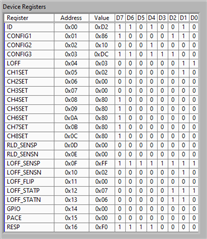Other Parts Discussed in Thread: ADS1298
I am testing the RLD functionality of ADS1298 using the ADS1298RECGFE-PDK and TI’s ADS1298XECGFE-PDK-SW software utility along with the FLUKE ProSim 8 patient simulator. The simulator has the functionality for adding 50Hz artifact (noise) to the ECG signal at different intensity levels.
During the testing the following were observed:
Case 1: When no artifact is added from the simulator but power cables are positioned intentionally near the leads so that the power noise is coupled, the RLD functionality of ADS1298 is functioning as expected, keeping the 50 Hz noise level at -96dbFS.
Case 2: With the same RLD configuration as Case 1, when the artifact is added from the simulator the 50 Hz noise does not get reduced by the RLD. On measuring the RLD signal using the RLD measurement option, it can be observed that the RLD signal has a -50dbFS magnitude at 50 Hz. But, despite this, the ECG channels contain 50 Hz artifacts at -58dbFS.
Is there any difference in the way that RLD behaves when connected to the Fluke ProSim 8 simulator as opposed to an actual patient? If you can provide an insight to what is happening, or if anyone else has experienced similar problems, it would be nice if any help is shared.
For simplicity, the following setup is being used at present:
- CH4 to CH8 powered down
- CH1 used for RLD Measurement
- CH2 and CH3 used for capturing limb & augmented limb leads
- LA, RA, LL used to derive RLD signal
Attaching the Register Map configuration

FFT of CH2 and CH3 signals in Case 2
FFT of CH1 signal (RLD measurement) in Case 2

